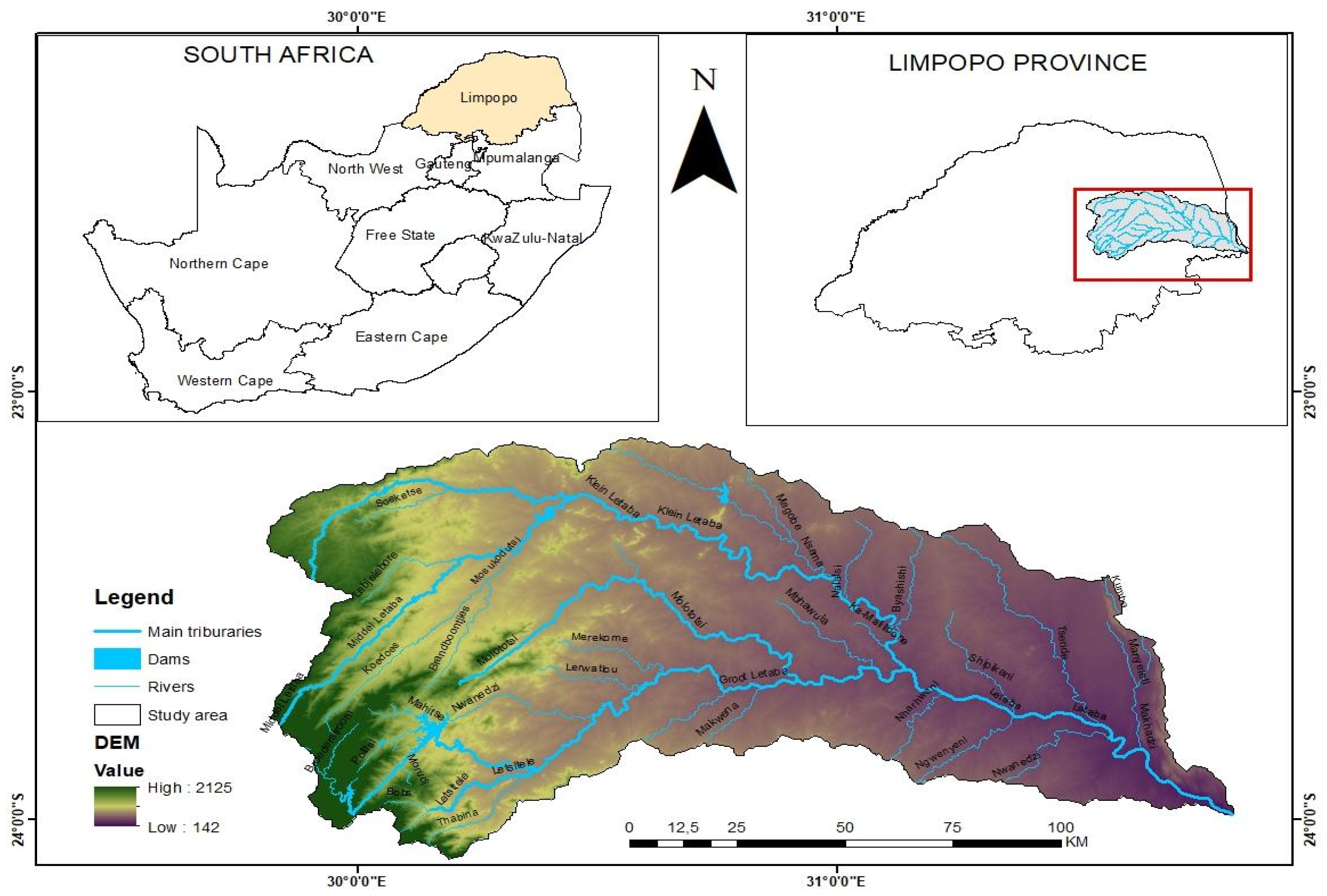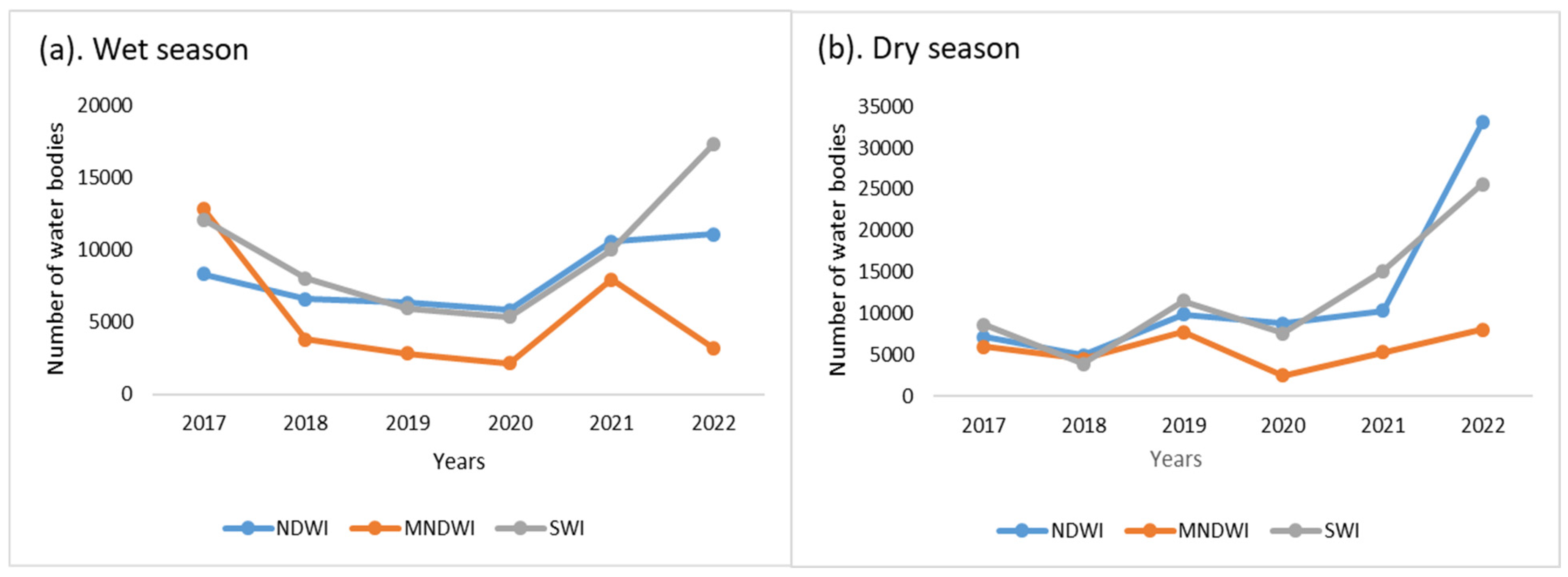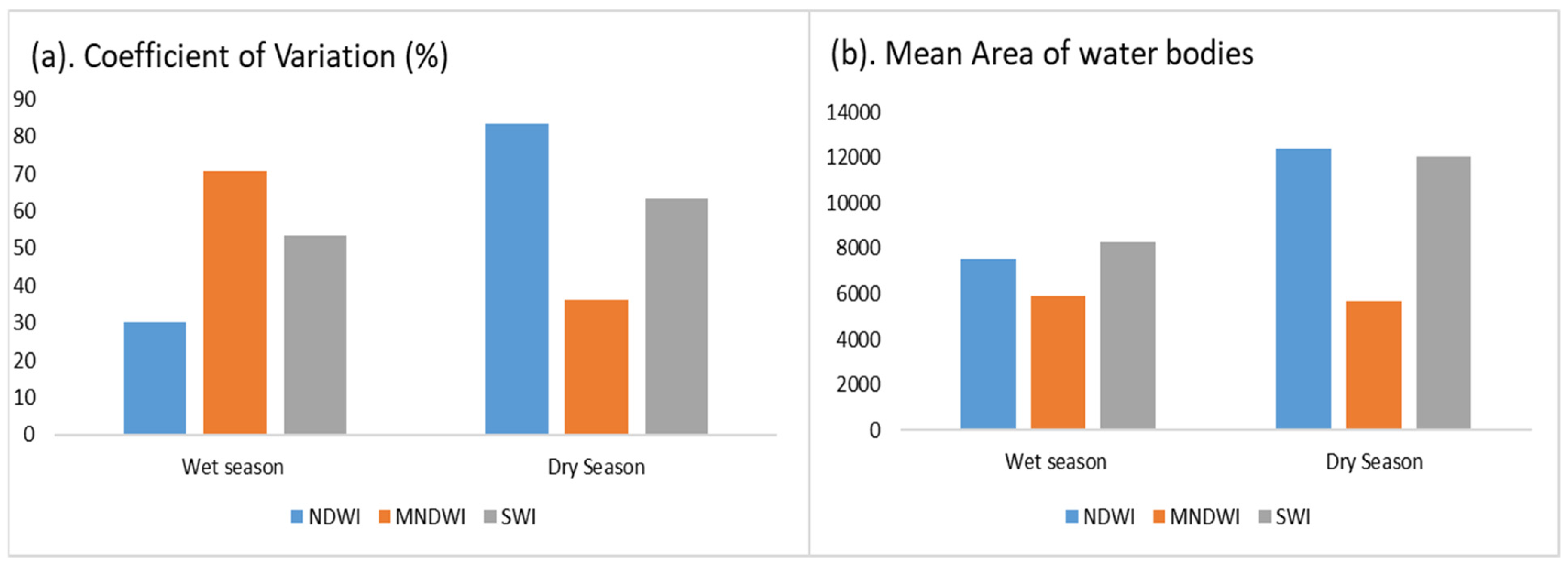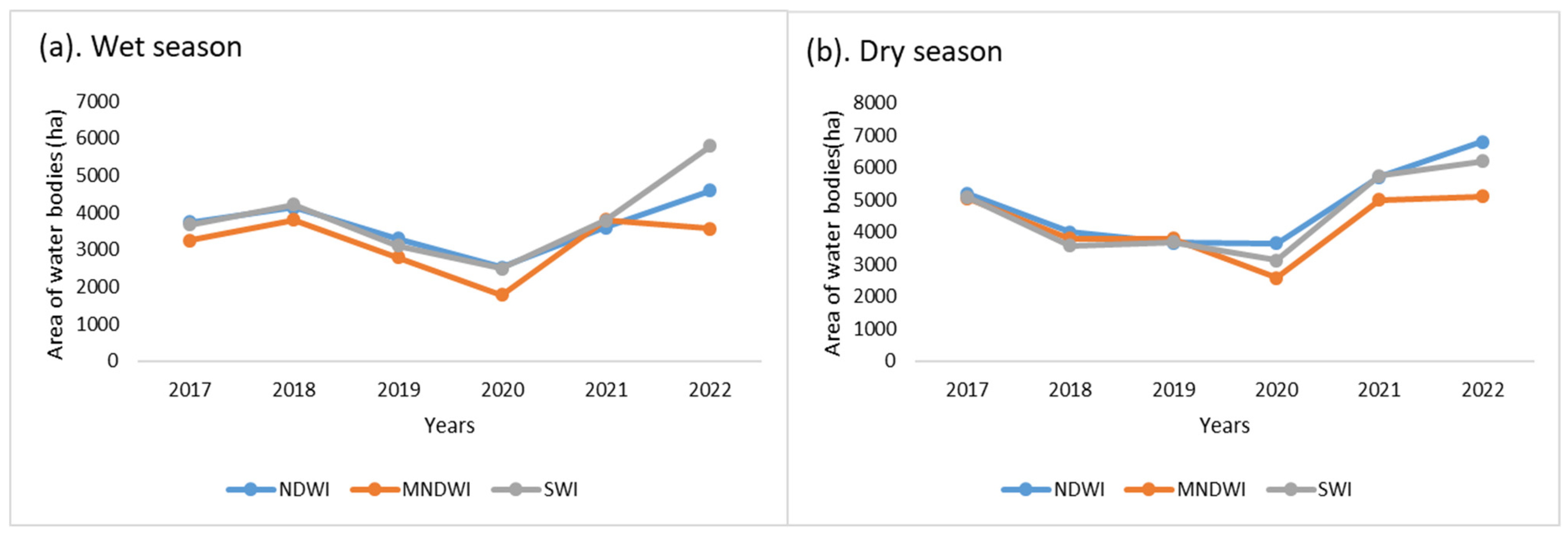Seasonal and Spatial Dynamics of Surface Water Resources in the Tropical Semi-Arid Area of the Letaba Catchment: Insights from Google Earth Engine, Landscape Metrics, and Sentinel-2 Imagery
Abstract
1. Introduction
2. Materials and Methods
2.1. Study Area
2.2. Data Acquisition and Analysis
2.3. Spectral Derived Indices
2.3.1. Extraction of Surface Water Bodies
2.3.2. Validation
- True positive (TP): number of accurate extracted water pixel points.
- False negative (FN): number of undetected water pixel points.
- False positive (FP): number of erroneously extracted water pixel points.
- True Negative (TN): number of non-water pixel points.
- Overall accuracy (%) = (TP + TN) × 100/Total number of pixel (T)
2.4. Spatial Configuration
- (i)
- Number of Water Bodies (NW): This metric represents the total number of distinct water bodies within a defined area. Monitoring NW helps to understand the proliferation or reduction in aquatic habitats, influenced by factors such as climate change, land use changes, or conservation efforts. This metric was calculated by converting the raster (water image) into vector data using the reduceToVectors function in Google Earth Engine (GEE), applying the parameter ee.reducer.countEvery to count the number of water bodies within the study area.
- (ii)
- Mean Area of Water Bodies (MAW): This metric provides the average size of water bodies, offering insights into habitat availability and the potential to support biodiversity. Changes in MAW may indicate ecological shifts, such as the drying up of smaller ponds or the expansion of larger lakes. To calculate MAW, the area of each water body was determined using the GEE function area. The area in hectares was then calculated by dividing by 10,000 using the divide function. The average water body area was computed using the following formula:
- (iii)
- Total Area of Water Bodies (TAW): This metric quantifies the total area covered by water bodies within a landscape. It reflects the overall extent of aquatic ecosystems, which is crucial for water resource management, flood control, and maintaining ecological balance. Fluctuations in TAW can indicate environmental changes or the effectiveness of water conservation efforts.
- (iv)
- Coefficient of Variation (CV): This metric is derived from the standard deviation of MAW, divided by the mean area of water bodies (MAW), and multiplied by 100. It measures the relative variability in the sizes of water bodies, highlighting the landscape’s heterogeneity. A high CV suggests a diverse range of water body sizes, which can be beneficial for supporting different species and ecological functions. Conversely, a low CV may indicate uniformity, potentially affecting habitat diversity.
3. Results
3.1. Water Indices and Validation
3.2. Intra and Inter-Seasonal Dynamics of Surface Water Bodies
4. Discussion
5. Conclusions
Author Contributions
Funding
Data Availability Statement
Conflicts of Interest
Abbreviations
| Google Earth Engine | GEE |
| Modified normalized difference water index | MNDWI |
| Short wavelength infrared | SWIR |
| False negative | FN |
| False positive | FP |
| Total Area of Water Bodies | TAW |
| Mean Area of Water Bodies | MWA |
| Number of Water Bodies | NWB |
| Normalized difference water index | NDWI |
| Coefficient of Variation | CV |
| True positive | TP |
| True Negative | TN |
| Sentinel Water Index | SWI |
References
- Rokni, K.; Ahmad, A.; Solaimani, K.; Hazini, S. A new approach for surface water change detection: Integration of pixel level image fusion and image classification techniques. Int. J. Appl. Earth Obs. Geoinf. 2015, 34, 226–234. [Google Scholar] [CrossRef]
- Khalid, H.W.; Khalil, R.M.Z.; Qureshi, M.A. Evaluating spectral indices for water bodies extraction in western Tibetan Plateau. Egypt. J. Remote Sens. Space Sci. 2021, 24, 619–634. [Google Scholar] [CrossRef]
- Verpoorter, C.; Kutser, T.; Tranvik, L. Automated mapping of water bodies using Landsat multispectral data. Limnol. Oceanogr. Methods 2012, 10, 1037–1050. [Google Scholar]
- Collet, L.; Ruelland, D.; Borrell-Estupina, V.; Servat, E. Assessing the long-term impact of climatic variability and human activities on the water resources of a meso-scale Mediterranean catchment. Hydrol. Sci. J. 2014, 59, 1457–1469. [Google Scholar]
- Haas, E.M.; Bartholomé, E.; Combal, B. Time series analysis of optical remote sensing data for the mapping of temporary surface water bodies in sub-Saharan western Africa. J. Hydrol. 2009, 370, 52–63. [Google Scholar] [CrossRef]
- Feyisa, G.L.; Meilby, H.; Fensholt, R.; Proud, S.R. Automated Water Extraction Index: A new technique for surface water mapping using Landsat imagery. Remote Sens. Environ. 2014, 140, 23–35. [Google Scholar] [CrossRef]
- Tulbure, M.G.; Broich, M. Spatiotemporal dynamic of surface water bodies using Landsat time-series data from 1999 to 2011. ISPRS J. Photogramm. Remote Sens. 2013, 79, 44–52. [Google Scholar] [CrossRef]
- Gan, R.; Zhang, Y.; Shi, H.; Yang, Y.; Eamus, D.; Cheng, L.; Chiew, F.H.; Yu, Q. Use of satellite leaf area index estimating evapotranspiration and gross assimilation for Australian ecosystems. Ecohydrology 2018, 11, e1974. [Google Scholar]
- Kusangaya, S.; Warburton, M.L.; Van Garderen, E.A.; Jewitt, G.P. Impacts of climate change on water resources in southern Africa: A review. Phys. Chem. Earth 2014, 67, 47–54. [Google Scholar]
- Bhangale, U.; More, S.; Shaikh, T.; Patil, S.; More, N. Analysis of surface water resources using Sentinel-2 imagery. Procedia Comput. Sci. 2020, 171, 2645–2654. [Google Scholar]
- Klein, I.; Dietz, A.J.; Gessner, U.; Galayeva, A.; Myrzakhmetov, A.; Kuenzer, C. Evaluation of seasonal water body extents in Central Asia over the past 27 years derived from medium-resolution remote sensing data. Int. J. Appl. Earth Obs. Geoinf. 2014, 26, 335–349. [Google Scholar] [CrossRef]
- Zou, Z.; Dong, J.; Menarguez, M.A.; Xiao, X.; Qin, Y.; Doughty, R.B.; Hooker, K.V.; Hambright, K.D. Continued decrease of open surface water body area in Oklahoma during 1984–2015. Sci. Total Environ. 2017, 595, 451–460. [Google Scholar] [PubMed]
- Sarp, G.; Ozcelik, M. Water body extraction and change detection using time series: A case study of Lake Burdur, Turkey. J. Taibah Univ. Sci. 2017, 11, 381–391. [Google Scholar] [CrossRef]
- Khandelwal, A.; Karpatne, A.; Marlier, M.E.; Kim, J.; Lettenmaier, D.P.; Kumar, V. An approach for global monitoring of surface water extent variations in reservoirs using MODIS data. Remote Sens. Environ. 2017, 202, 113–128. [Google Scholar] [CrossRef]
- Pickens, A.H.; Hansen, M.C.; Hancher, M.; Stehman, S.V.; Tyukavina, A.; Potapov, P.; Marroquin, B.; Sherani, Z. Mapping and sampling to characterize global inland water dynamics from 1999 to 2018 with full Landsat time-series. Remote Sens. Environ. 2020, 243, 111792. [Google Scholar]
- Fisher, A.; Flood, N.; Danaher, T. Comparing Landsat water index methods for automated water classification in eastern Australia. Remote Sens. Environ. 2016, 175, 167–182. [Google Scholar] [CrossRef]
- Mashala, M.J.; Dube, T.; Mudereri, B.T.; Ayisi, K.K.; Ramudzuli, M.R. A Systematic Review on Advancements in Remote Sensing for Assessing and Monitoring Land Use and Land Cover Changes Impacts on Surface Water Resources in Semi-Arid Tropical Environments. Remote Sens. 2023, 15, 3926. [Google Scholar] [CrossRef]
- Jiang, W.; Ni, Y.; Pang, Z.; Li, X.; Ju, H.; He, G.; Lv, J.; Yang, K.; Fu, J.; Qin, X. An effective water body extraction method with new water index for sentinel-2 imagery. Water 2021, 13, 1647. [Google Scholar] [CrossRef]
- Yang, X.; Zhao, S.; Qin, X.; Zhao, N.; Liang, L. Mapping of urban surface water bodies from Sentinel-2 MSI imagery at 10 m resolution via NDWI-based image sharpening. Remote Sens. 2017, 9, 596. [Google Scholar] [CrossRef]
- Mashala, M.J.; Dube, T.; Ayisi, K.K.; Ramudzuli, M.R. Using the Google Earth Engine cloud-computing platform to assess the long-term spatial temporal dynamics of land use and land cover within the Letaba watershed, South Africa. Geocarto Int. 2023, 38, 2252781. [Google Scholar] [CrossRef]
- Shafizadeh-Moghadam, H.; Khazaei, M.; Alavipanah, S.K.; Weng, Q. Google Earth Engine for large-scale land use and land cover mapping: An object-based classification approach using spectral, textural and topographical factors. GIScience Remote Sens. 2021, 58, 914–928. [Google Scholar]
- Sherjah, P.Y.; Sajikumar, N.; Nowshaja, P.T. Quality monitoring of inland water bodies using Google Earth Engine. J. Hydroinformatics 2023, 25, 432–450. [Google Scholar]
- Gujrati, A.; Jha, V.B. Surface water dynamics of inland water bodies of India using Google Earth Engine. ISPRS Ann. Photogramm. Remote Sens. Spat. Inf. Sci. 2018, 4, 467–472. [Google Scholar]
- Nguyen, U.N.; Pham, L.T.; Dang, T.D. An automatic water detection approach using Landsat 8 OLI and Google Earth Engine cloud computing to map lakes and reservoirs in New Zealand. Environ. Monit. Assess. 2019, 191, 235. [Google Scholar]
- Frazier, A.E.; Kedron, P. Landscape metrics: Past progress and future directions. Curr. Landsc. Ecol. Rep. 2017, 2, 63–72. [Google Scholar]
- Walz, U. Landscape structure, landscape metrics and biodiversity. Living Rev. Landsc. Res. 2011, 5, 1–35. [Google Scholar]
- DWAF. Letaba Catchment Reserve Determination Study; February 2006; Department of Water Affairs and Forestry: Pretoria, South Africa, 2006. [Google Scholar]
- Tucker, C.J. Red and photographicinfrared linear combinations for monitoring vegetation. Remote Sens. Environ. 1979, 8, 127–150. [Google Scholar]
- Gao, B.C. Normalized difference water index for remote sensing of vegetation liquid water from space. In Proceedings of the SPIE’S 1995 Symposium on OE/Aerospace Sensing and Dual Use Photonics, Orlando, FL, USA, 17–21 April 1995; pp. 225–236. [Google Scholar] [CrossRef]
- Acharya, T.D.; Subedi, A.; Lee, D.H. Evaluation of water indices for surface water extraction in a Landsat 8 scene of Nepal. Sensors 2018, 18, 2580. [Google Scholar] [CrossRef]
- Zhai, K.; Wu, X.; Qin, Y.; Du, P. Comparison of surface water extraction performances of different classic water indices using OLI and TM imageries in different situations. Geo-Spat. Inf. Sci. 2015, 18, 32–42. [Google Scholar] [CrossRef]
- Zhou, Y.; Dong, J.; Xiao, X.; Xiao, T.; Yang, Z.; Zhao, G.; Zou, Z.; Qin, Y. Open surface water mapping algorithms: A comparison of water-related spectral indices and sensors. Water 2017, 9, 256. [Google Scholar] [CrossRef]
- Șerban, C.; Maftei, C.; Dobrică, G. Surface water change detection via water indices and predictive modeling using remote sensing imagery: A case study of Nuntasi-Tuzla Lake, Romania. Water 2022, 14, 556. [Google Scholar] [CrossRef]
- McFeeters, S.K. The use of the Normalized Difference Water Index (NDWI) in the delineation of open water features. Int. J. Remote Sens. 1996, 17, 1425–1432. [Google Scholar]
- Xu, H. Modification of normalised difference water index (NDWI) to enhance open water features in remotely sensed imagery. Int. J. Remote Sens. 2006, 27, 3025–3033. [Google Scholar]
- Albarqouni, M.M. Yagmur, N. Bektas Balcik, F.; Sekertekin, A. Assessment of Spatio-Temporal Changes in Water Surface Extents and Lake Surface Temperatures Using Google Earth Engine for Lakes Region, Türkiye. ISPRS Int. J. Geo-Inf. 2022, 11, 407. [Google Scholar] [CrossRef]
- Yesuph, A.Y.; Dagnew, A.B. Land use/cover spatiotemporal dynamics, driving forces and implications at the Beshillo catchment of the Blue Nile Basin, North Eastern Highlands of Ethiopia. Environ. Syst. Res. 2019, 8, 21. [Google Scholar]
- Kandekar, V.U.; Pande, C.B.; Rajesh, J.; Atre, A.A.; Gorantiwar, S.D.; Kadam, S.A.; Gavit, B. Surface water dynamics analysis based on sentinel imagery and Google Earth Engine Platform: A case study of Jayakwadi dam. Sustain. Water Resour. Manag. 2021, 7, 44. [Google Scholar]
- Lombana, L.; Martínez-Graña, A. A Flood Mapping Method for Land Use Management in Small-Size Water Bodies: Validation of Spectral Indexes and a Machine Learning Technique. Agronomy 2022, 12, 1280. [Google Scholar] [CrossRef]
- Marzi, D.; Gamba, P. Inland water body mapping using multitemporal sentinel-1 sar data. IEEE J. Sel. Top. Appl. Earth Obs. Remote Sens. 2021, 14, 11789–11799. [Google Scholar]
- Musa, Z.N.; Popescu, I.; Mynett, A. A review of applications of satellite SAR, optical, altimetry and DEM data for surface water modelling, mapping and parameter estimation. Hydrol. Earth Syst. Sci. 2015, 19, 3755–3769. [Google Scholar]
- Wu, F.; Yang, X.; Cui, Z.; Ren, L.; Jiang, S.; Liu, Y.; Yuan, S. The impact of human activities on blue-green water resources and quantification of water resource scarcity in the Yangtze River Basin. Sci. Total Environ. 2024, 909, 168550. [Google Scholar]
- Anusha, B.N.; Babu, K.R.; Kumar, B.P.; Kumar, P.R.; Rajasekhar, M. Geospatial approaches for monitoring and mapping of water resources in semi-arid regions of Southern India. Environ. Chall. 2022, 8, 100569. [Google Scholar]
- Laonamsai, J.; Julphunthong, P.; Saprathet, T.; Kimmany, B.; Ganchanasuragit, T.; Chomcheawchan, P.; Tomun, N. Utilizing NDWI, MNDWI, SAVI, WRI, and AWEI for estimating erosion and deposition in Ping River in Thailand. Hydrology 2023, 10, 70. [Google Scholar] [CrossRef]
- Masocha, M.; Dube, T.; Makore, M.; Shekede, M.D.; Funani, J. Surface water bodies mapping in Zimbabwe using landsat 8 OLI multispectral imagery: A comparison of multiple water indices. Phys. Chem. Earth Parts A/B/C 2018, 106, 63–67. [Google Scholar] [CrossRef]
- Rajeswari, S.; Rathika, P. Exploring Spectral Indices for Improved Water Body Classification in Landsat Imagery. In Proceedings of the 2024 Third International Conference on Intelligent Techniques in Control, Optimization and Signal Processing (INCOS), Virudhunagar, India, 14–16 March 2024; pp. 1–5. [Google Scholar]






| Band Name | Band Number in GEE | Band Resolution |
|---|---|---|
| Coastal Aerosol | SR_B1 | 60 |
| Green | SR_B2 | 10 |
| Red | SR_B3 | 10 |
| Blue | SR_B4 | 10 |
| Vegetation Red Edge | SR_B5 | 20 |
| Vegetation Red Edge | SR_B6 | 20 |
| Vegetation Red Edge | SR_B7 | 20 |
| Near-Infrared (NIR) | SR_B8 | 10 |
| Narrow NIR | SR_B8A | 20 |
| Water Vapor | SR_B9 | 60 |
| Shortwave Infrared 1 (SWIR-1) | SR_B11 | 20 |
| Shortwave Infrared 2 (SWIR-2) | SR_B12 | 20 |
| Shortwave Infrared 3 (SWIR-3) | SR_B13 | 20 |
| Cloud Mask | QA60 | 60 |
| Water Indices | Formulae | Threshold | Reference |
|---|---|---|---|
| Normalized difference water index (NDWI) | NDWI = (Green − NIR)/(Green + NIR) | NDWI > 0 | [34] |
| Modified normalized difference water index (MNDWI) | MNDWI = (Green − SWIR2)/(Green + SWIR2) | MNDWI > 0 | [35] |
| Sentinel 2 Water Index (SWI) | SWI = (Red edge − SWIR2)/(Red edge + SWIR2) | SWI > 0 | [18] |
| (a) | Dry Season | ||||||||
|---|---|---|---|---|---|---|---|---|---|
| NDWI | MNDWI | SWI | |||||||
| OA% | UA% | PA% | OA% | UA% | PA% | OA% | UA% | PA% | |
| 2017 | 99 | 99 | 100 | 94 | 92 | 99 | 99 | 99 | 100 |
| 2018 | 98 | 98 | 100 | 96 | 95 | 99 | 98 | 98 | 100 |
| 2019 | 99 | 98 | 100 | 96 | 96 | 99 | 99 | 98 | 100 |
| 2020 | 96 | 94 | 99 | 92 | 92 | 99 | 98 | 97 | 99 |
| 2021 | 99 | 96 | 100 | 98 | 97 | 99 | 99 | 99 | 100 |
| 2022 | 100 | 100 | 100 | 99 | 99 | 100 | 98 | 97 | 100 |
| (b) | Wet season | ||||||||
| NDWI | MNDWI | SWI | |||||||
| OA% | UA% | PA% | OA% | UA% | PA% | OA% | UA% | PA% | |
| 2017 | 99 | 99 | 100 | 99 | 99 | 100 | 99 | 98 | 100 |
| 2018 | 98 | 98 | 100 | 98 | 98 | 99 | 98 | 98 | 100 |
| 2019 | 99 | 98 | 100 | 96 | 95 | 100 | 99 | 98 | 100 |
| 2020 | 96 | 95 | 99 | 94 | 92 | 99 | 95 | 94 | 99 |
| 2021 | 99 | 98 | 100 | 99 | 98 | 99 | 99 | 99 | 100 |
| 2022 | 100 | 100 | 100 | 98 | 80 | 100 | 98 | 97 | 100 |
Disclaimer/Publisher’s Note: The statements, opinions and data contained in all publications are solely those of the individual author(s) and contributor(s) and not of MDPI and/or the editor(s). MDPI and/or the editor(s) disclaim responsibility for any injury to people or property resulting from any ideas, methods, instructions or products referred to in the content. |
© 2025 by the authors. Licensee MDPI, Basel, Switzerland. This article is an open access article distributed under the terms and conditions of the Creative Commons Attribution (CC BY) license (https://creativecommons.org/licenses/by/4.0/).
Share and Cite
Mashala, M.J.; Dube, T.; Ayisi, K.K. Seasonal and Spatial Dynamics of Surface Water Resources in the Tropical Semi-Arid Area of the Letaba Catchment: Insights from Google Earth Engine, Landscape Metrics, and Sentinel-2 Imagery. Hydrology 2025, 12, 68. https://doi.org/10.3390/hydrology12040068
Mashala MJ, Dube T, Ayisi KK. Seasonal and Spatial Dynamics of Surface Water Resources in the Tropical Semi-Arid Area of the Letaba Catchment: Insights from Google Earth Engine, Landscape Metrics, and Sentinel-2 Imagery. Hydrology. 2025; 12(4):68. https://doi.org/10.3390/hydrology12040068
Chicago/Turabian StyleMashala, Makgabo Johanna, Timothy Dube, and Kingsley Kwabena Ayisi. 2025. "Seasonal and Spatial Dynamics of Surface Water Resources in the Tropical Semi-Arid Area of the Letaba Catchment: Insights from Google Earth Engine, Landscape Metrics, and Sentinel-2 Imagery" Hydrology 12, no. 4: 68. https://doi.org/10.3390/hydrology12040068
APA StyleMashala, M. J., Dube, T., & Ayisi, K. K. (2025). Seasonal and Spatial Dynamics of Surface Water Resources in the Tropical Semi-Arid Area of the Letaba Catchment: Insights from Google Earth Engine, Landscape Metrics, and Sentinel-2 Imagery. Hydrology, 12(4), 68. https://doi.org/10.3390/hydrology12040068







